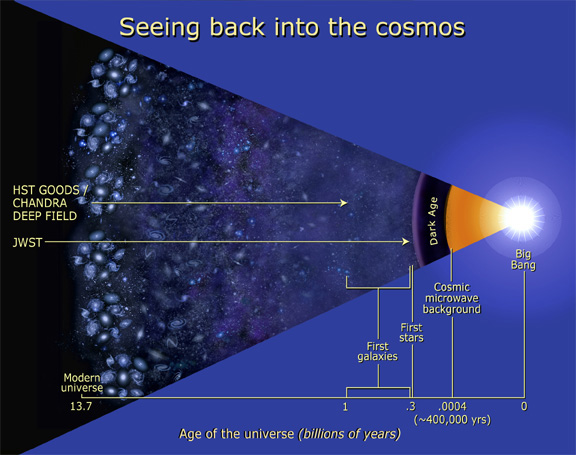As commonly known, the James Webb Space Telescope (JSWT) has been sent to Lagrange point 2 (L2) to receive reports from the past of the universe, and it does this by measuring several factors such as distant star light and other information as light is finite in speed. I wanted to learn how the JWST exactly researches such distant stars and what instruments it used for the same and how they work to discover the past?
-
3$\begingroup$ Related: astronomy.stackexchange.com/questions/47244/… $\endgroup$– fyrepenguinCommented May 30 at 8:19
-
1$\begingroup$ Quibble: By reading the tag's definition (that specifically excludes the sun), the tag "artificial-satellite" is (in my estimation) inappropriate in reference to the JWST that primarily "orbits" a phenomenon, not a tangible body... $\endgroup$– user54818Commented May 31 at 1:44
1 Answer
The James Webb Space Telescope's (JWST's) ability to see "back in time" better than earlier telescopes is possible not only because it has a larger primary mirror, but also because of the way it was designed, where it is located, and how it is operated.
The following figure sheds some light (pardon the pun) on the astrophysics of how the JWST "sees" further back in time. The light from further back in time started from locations in space that are further away from us - points closer to the edge of the observable universe.
Because the universe is expanding, these faraway locations are moving away from us more rapidly than locations closer to us. This causes the light coming from these faraway locations to appear more red-shifted.
When light is red-shifted, its frequency decreases, and its wavelength increases. For example, red-shifted visible light may become near-infrared light or even mid-infrared light. As light is red-shifted into the infrared portion of the electromagnetic spectrum, it becomes hard for less advanced telescopes to image it. This occurs because these less advanced telescopes are warmer so their parts also emit infrared light. The infrared light from the distant object is then washed out by all of the infrared light that the telescope itself emits.
The JWST uses a hot-side-cold-side architecture to prevent the infrared light received from the most distant celestial objects from being washed out. Its sunshield prevents the sun's energy from warming its cold side, which is where the optical elements and detectors are located. Because the telescope is located at the Earth-Sun L2 point, the sunshield can prevent reflected sunlight from the Earth and the Moon from warming the cold side too. This allows the cold side to radiate its heat away into interstellar space. The cold side passively cools itself all the way down to -236°C, or 37K. (see How can electronics on board JWST survive the low operating temperature while it's difficult to survive lunar nights? for more details), which is sufficient for three of Webb's four scientific instruments to operate. The fourth instrument, the Mid-infrared Instrument, or MIRI, needs to be at a temperature of less than 7 kelvins to operate properly, so Webb carries a "cryocooler" that is dedicated to cooling MIRI's detectors.
The first three instruments (NIRCAM, NIRSpec, and FGS/NIRISS) use mercury-cadmium-telluride (abbreviated HgCdTe) "H2RG" detectors for the 0.6-5 μm "near-infrared" (about 4 million pixels) and the fourth (MIRI) uses arsenic-doped silicon (abbreviated Si:As) detectors for the 5-28 μm "mid-infrared" (about 1 million pixels). Below is an image of a Near Infrared Camera (NIRCam) detector.
 (ref)
(ref)
By keeping the telescope's optical and imaging parts cool, and by using a large primary reflector to gather a lot of light, the telescope can image very faint and distant objects.
But another operational trick that JWST (and other telescopes) use to see objects that are really far away is gravitational lensing, which uses the curvature of space around an object in the foreground to magnify an object that happens to be directly behind it.
-
9$\begingroup$ Your answer has been appreciated and pun excused $\endgroup$ Commented May 30 at 9:27
-
1
